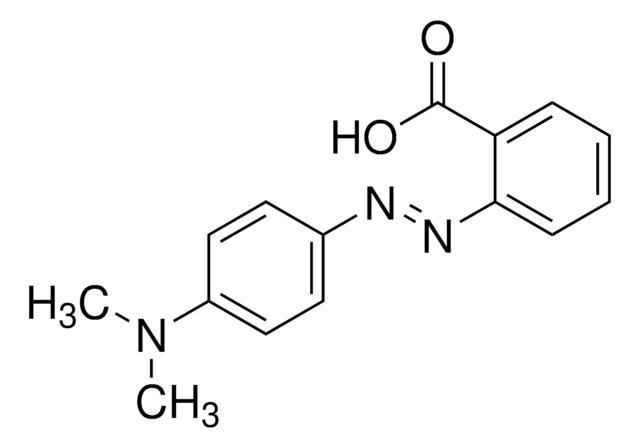1.01322
Methyl orange (C.I. 13025)
pH indicator, ACS, Reag. Ph Eur
Sinonimo/i:
Methyl orange (C.I. 13025), 4-Dimethylaminoazobenzene-4′-sulfonic acid sodium salt, Gold orange, Helianthine, Orange III
About This Item
Prodotti consigliati
product name
Methyl orange (C.I. 13025), indicator ACS,Reag. Ph Eur
Grado
ACS reagent
Livello qualitativo
agenzia
reag. Ph. Eur.
Forma fisica
solid
Potenza
60 mg/kg LD50, oral (Rat)
Perdita
≤5% loss on drying, 110°C
pH
6.5 (20 °C, 5 g/L in H2O)
Punto di fusione
>300 °C
Densità bulk
200‑400 kg/m3
Temperatura di conservazione
2-30°C
InChI
1S/C14H15N3O3S/c1-17(2)13-7-3-11(4-8-13)15-16-12-5-9-14(10-6-12)21(18,19)20/h3-10H,1-2H3,(H,18,19,20)/p-1
IETWCRRCPURZOC-UHFFFAOYSA-M
Applicazioni
- Plant-assisted green preparation of silver nanoparticles using leaf extract of Dalbergia sissoo and their antioxidant, antibacterial and catalytic applications.: This research utilized Methyl Orange as an indicator in the green synthesis of silver nanoparticles using Dalbergia sissoo leaf extract. The study highlighted its catalytic application in dye degradation, demonstrating the environmental benefits of plant-assisted nanoparticle synthesis (Khatun et al., 2024).
- Dye Degradation and Sulfur Oxidation of Methyl Orange and Thiophenol via Newly Designed Nanocomposite GQDs/NiSe-NiO Photocatalyst Under Homemade LED Light.: This study focused on the efficient photocatalytic degradation of Methyl Orange using a novel nanocomposite photocatalyst under LED light, presenting significant advancements in photocatalytic materials for wastewater treatment (Srivastava et al., 2023).
- Bryophyllum pinnatum leaf extract mediated ZnO nanoparticles with prodigious potential for solar driven photocatalytic degradation of industrial contaminants.: The research demonstrated the synthesis of ZnO nanoparticles using Bryophyllum pinnatum leaf extract and their application in the photocatalytic degradation of Methyl Orange, showcasing a sustainable approach to tackling industrial pollutants (Dhiman et al., 2023).
- Light driven Aspergillus niger-ZnS nanobiohybrids for degradation of methyl orange.: This paper explored the use of Aspergillus niger-ZnS nanobiohybrids for the degradation of Methyl Orange, emphasizing the potential of biogenic approaches in enhancing photocatalytic efficiency (Priyanka & Lens, 2022).
- Bacterially driven cadmium sulfide precipitation on porous membranes: Toward platforms for photocatalytic applications.: This study utilized Methyl Orange to assess the photocatalytic efficiency of cadmium sulfide precipitated on porous membranes by bacteria, proposing a novel method for creating photocatalytic platforms for environmental applications (Marusak et al., 2018).
Risultati analitici
Appearance of solution: passes test
Loss on drying (110 °C): ≤ 5
Transition range (according to ACS): passes test
Sensitivity test: passes test
Avvertenze
Danger
Indicazioni di pericolo
Consigli di prudenza
Classi di pericolo
Acute Tox. 3 Oral
Codice della classe di stoccaggio
6.1C - Combustible, acute toxic Cat.3 / toxic compounds or compounds which causing chronic effects
Classe di pericolosità dell'acqua (WGK)
WGK 3
Punto d’infiammabilità (°F)
Not applicable
Punto d’infiammabilità (°C)
Not applicable
Certificati d'analisi (COA)
Cerca il Certificati d'analisi (COA) digitando il numero di lotto/batch corrispondente. I numeri di lotto o di batch sono stampati sull'etichetta dei prodotti dopo la parola ‘Lotto’ o ‘Batch’.
Possiedi già questo prodotto?
I documenti relativi ai prodotti acquistati recentemente sono disponibili nell’Archivio dei documenti.
I clienti hanno visto anche
Il team dei nostri ricercatori vanta grande esperienza in tutte le aree della ricerca quali Life Science, scienza dei materiali, sintesi chimica, cromatografia, discipline analitiche, ecc..
Contatta l'Assistenza Tecnica.









